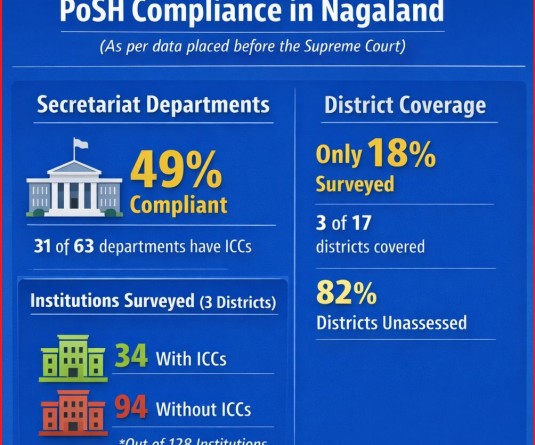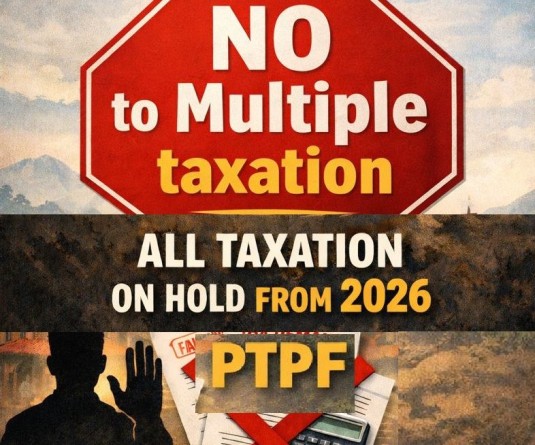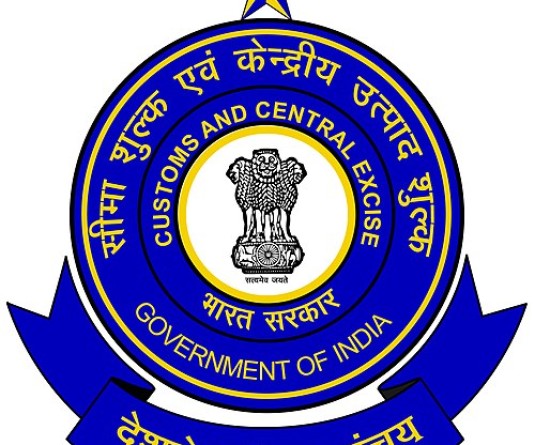Shinde Suresh Kailasrao, SP Narcotics (Middle), Dr Bernice D Thapru, Joint Director (TI), NSACS (2nd from left), K Sonikumar Singh, Assistant Director, PIB Kohima along with other officials during the press conference on International Day Against Drug Abuse & Illicit Trafficking at Kohima Press Club Office on June 26. (Morung Photo)

PIB Kohima organises press conference to mark the ‘International Day Against Drug Abuse & Illicit Trafficking’
Morung Express News
Kohima | June 26
More than 270 cases have been registered and over 465 persons have been apprehended in Nagaland under the Narcotic Drugs and Psychotropic Substances (NDPS) Act, 1985 since last year, informed Shinde Suresh Kailasrao, the State’s Superintendent of Police (SP) for Narcotics, on Thursday.
Addressing a press conference organised by the Press Information Bureau (PIB) Kohima to mark the ‘International Day Against Drug Abuse & Illicit Trafficking’ at the Kohima Press Club Office on June 26, he also highlighted the various challenges faced by enforcement agencies in tackling illicit drug trafficking.
These included multiple routes and multiple ways of concealment.
“There are so many porous borders, and so many players are involved in this entire drug trafficking network,” Kailasrao added, highlighting that the 215-km-long international border with Myanmar and the State’s proximity to the infamous Golden Triangle make it a transit point for drugs headed to other states.
Elaborating further, the SP (Narcotics) noted that drug traffickers use several key routes in Nagaland to transit drugs to other states.
Drugs such as heroin, ‘Shanflower,’ opium, and ganja often enter Nagaland via Manipur. Other prominent routes include the Khuzama Check Gate through Kohima to Dimapur and the Tadubi–Peren–Jalukie route to Dimapur, from where the drugs are transported to the rest of the country.
Another route originates from the Myanmar border via Mon district, while drugs also move from Longleng through Mokokchung to other parts of Nagaland and beyond.
Drugs also enter Nagaland from the Assam side as well, Kailasrao added.
Diverse profiles of carriers
Interestingly, drug carriers who have been apprehended in the recent past indicate diverse profiles. According to the SP, these include illiterates, graduates, athletes, women, and some who are highly trained, in the age group of 18–75 years.
“It is having an impact on all kinds of age groups, professions, and even social structures,” he pointed out.
Pointing out that “through our surveillance, human intelligence, tech inputs, Nagaland Police is trying their best to contain this menace,” he however underscored that, “to eliminate or to reduce negligence levels, all society needs to come together because unless and until all people like civil society organisations, NGOs, even the schools, the media persons and other government offices come together, we can't fight this drug menace completely.”
However, on the line of prevention and demand reduction, he asserted that Nagaland Police is actively engaged and urged cooperation from the people of Nagaland.
“Whenever you get any kind of information, please share with the Nagaland Police. As per NDPS reward guidelines, your identity will be kept anonymous and you will also be rewarded if significant seizures happen. So I request all of you to come together,” he highlighted.
‘Drug abuse challenges are huge’
Also addressing the media, Dr Bernice D Thapru, Joint Director (Prevention), Nagaland State AIDS Control Society (NSACS), stated that drug abuse has existed since early civilisation and remains a major challenge.
She also pointed to the State’s proximity to the Golden Triangle as a factor contributing to its increased vulnerability.
However, she asserted that Nagaland is going forefront in addressing the problem and expressed hope that, with coordinated efforts from all relevant agencies, the challenges can be overcome.
Speaking on “Effects of Drug Abuse,” Dr Thapru stressed the need to minimise its impact and work towards eventual elimination, acknowledging the challenges involved.
She also emphasised the vital role of civil society and the media, alongside government departments, in spreading accurate information to the public.
To address drug abuse, she also listed three broad strategies – supply reduction, demand reduction, and harm reduction.
Supply reduction focuses on controlling, monitoring, and addressing the inflow of illicit drugs, while demand reduction aims to prevent or delay the initiation of drug use, primarily by creating awareness among young people through the involvement of schools, communities, and families, she highlighted.
Harm reduction aims to ensure that individuals, whether actively using drugs or on the path to recovery, are protected from other harms, she added.
The NSACS Joint Director further explained that harm extends beyond physical or individual impacts, noting that drug users are also often vulnerable to crime, social exclusion, and reduced productivity, including absenteeism from work.
All these factors have broader economic implications for the State, she stressed.
Earlier, K Sonikumar Singh, Assistant Director PIB Kohima, who also moderated the media interaction, gave an overview of the discussion and objectives of organising the press conference.






